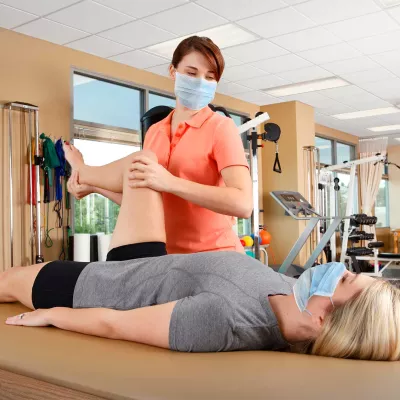- AdventHealth

On February 23, pro golfer Tiger Woods was driving on Hawthorne Boulevard in Los Angeles County, in an area known for curved roads and steep slopes, when he crashed his vehicle. Woods’ SUV crossed the center median and the opposing traffic lane before rolling over several times, eventually coming to a stop.
Following the accident, Woods was taken for medical evaluation where it was discovered that he suffered fractures on the upper and lower part of both the fibula and tibia, as well as severe ankle and foot injuries.
A Closer Look at Woods’ Injuries
Dr. Anish Mahajan, chief medical officer and interim CEO at Harbor-UCLA Medical Center, said Woods “suffered significant orthopedic injuries.” At this time, there are few details of Woods’ surgery, but we know that a rod was inserted in his lower right leg to stabilize the area crushed during his accident, and that doctors had to place screws and pins in his ankle and foot to stabilize additional injuries.
Doctors also performed fasciotomies, a procedure in which the muscle in the foot/ankle area is sliced open to relieve pressure and swelling, preventing the disabling condition known as “compartment syndrome” from occurring.
Woods had what’s known as “comminuted open fractures” affecting both the upper and lower tibia and fibula. “This term means that the two bones of the lower leg were fractured into many pieces and the skin and soft tissue around these pieces tore open, allowing the bones to be in contact with the outside environment,” says Dr. Michael Hawks, AdventHealth’s lead orthopedic trauma surgeon.
“He is incredibly lucky to be able to come out of this horrific accident, but the orthopedic injuries he sustained are significant and will require considerable time and effort to heal and recover fully,” explains Dr. Hawks.
Surgery and The Road to Recovery
Woods was immediately taken to Harbor-UCLA Medical Center in Los Angeles to begin emergency orthopedic surgery, following his crash. He’s since been transferred to Cedars-Sinai Medical Center where he’s started his recovery process.
“Woods sustained multiple injuries, including open fractures, deep wounds and compartment syndrome — a dangerous increase in pressure of the leg that, left untreated, could result in loss of function and sensation to the leg. The surgeons acted quickly to relieve pressure, clean the wounds and stabilize the fractures. While deep infection remains a possibility, prompt treatment greatly reduces this risk,” says Dr. Hawks.
It’s thought that the biggest concerns for Woods in the coming days will be the risk of infection and the loss of muscle tissue secondary to the initial trauma.
It is more than likely that Woods will need more than one surgery to recover from his injuries. “These procedures may include further ‘resetting’ of the broken bones, cleaning of open wounds, moving muscle to cover exposed bone, and skin grafting. There could still be a long road ahead before he can begin regaining his strength and function,” Dr. Hawks says.
Woods has recovered from five spinal surgeries, the most recent being in December 2020, and he was anticipating a return to golf this spring, prior to the car accident, so there’s no telling how much of a setback these injuries will be for his career.
In order for it to be possible for Tiger Woods to return to golf, there are two necessary parts to his healing process: healing from the injuries, and healing from the surgery. “Tiger’s fractures, his broken bones, will likely take months to completely heal,” Dr. Hawks says.
How Physical Therapy Promotes Healing
Woods will hopefully begin physical therapy shortly after his surgery, if he hasn’t started already, which benefits his healing process. In many cases, people don’t need a physician referral for physical therapy, so therapists can care for people early on to facilitate a faster recovery.
Physical therapy gets people moving soon after surgery, promoting faster recovery of mobility and independence and, in turn, a faster return to activity. It prevents a loss of mobility and strength during early recovery.
But initial physical therapy isn’t the type that most people envision, like exercising, “Early on, physical therapy is not primarily for strength or flexibility. The goal is simply to get you to stand and walk with assistive devices like crutches or walkers,” Dr. Hawks says.
Small Steps First
Getting moving soon after surgery, in as many gentle ways as possible, is one of the keys to a faster recovery. The first steps in Tiger Woods’ physical therapy will likely include relearning how to:
- Get up from a bed
- Get up from out of chairs
- Restore balance to prevent falls
- Walk up and down stairs
- Walk without assistance
Although the steps to recovery may be small at first, physical therapy empowers people to return to the activities that are most important to them and improve their quality of life.
Learn more about ways advanced orthopedic care can help you heal from injuries. For more information about injury prevention or to speak with a physical therapist, visit AdventHealth Sports Med and Rehab.
Image courtesy of Keith Allison, CC BY-SA 2.0 https://creativecommons.org/licenses/by-sa/2.0 via Wikimedia Commons
Recent Blogs

Here are some strategies to reduce stress and anxiety, along with symptoms to look for and who’s at the highest risk.


